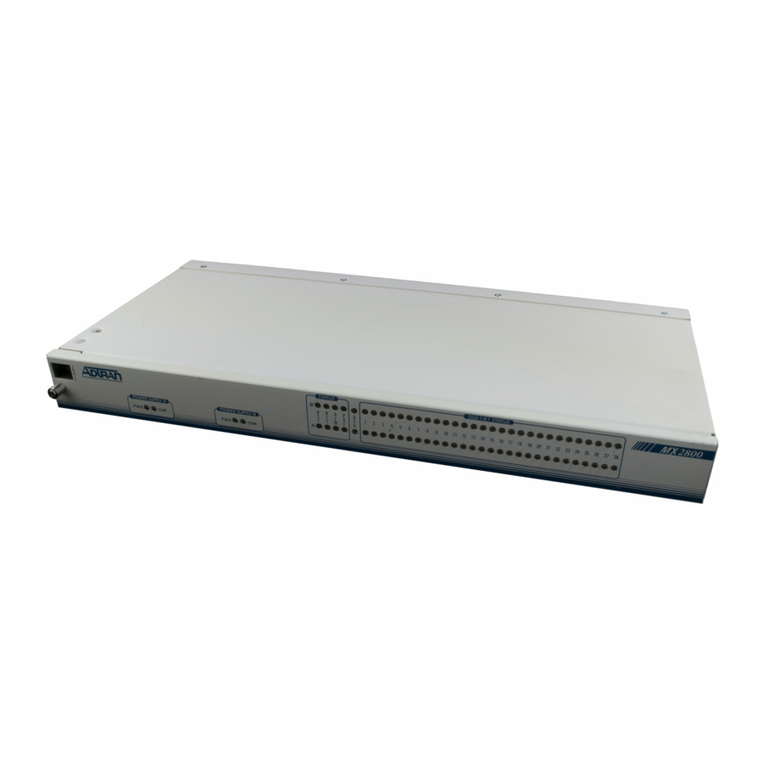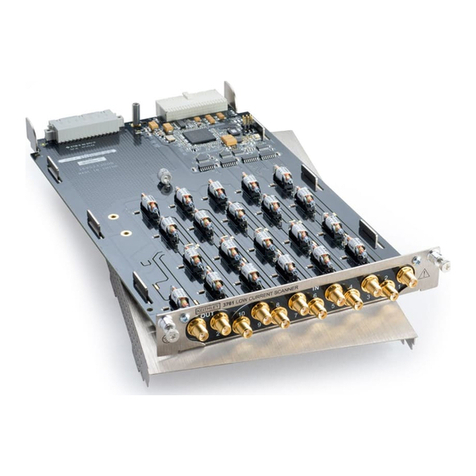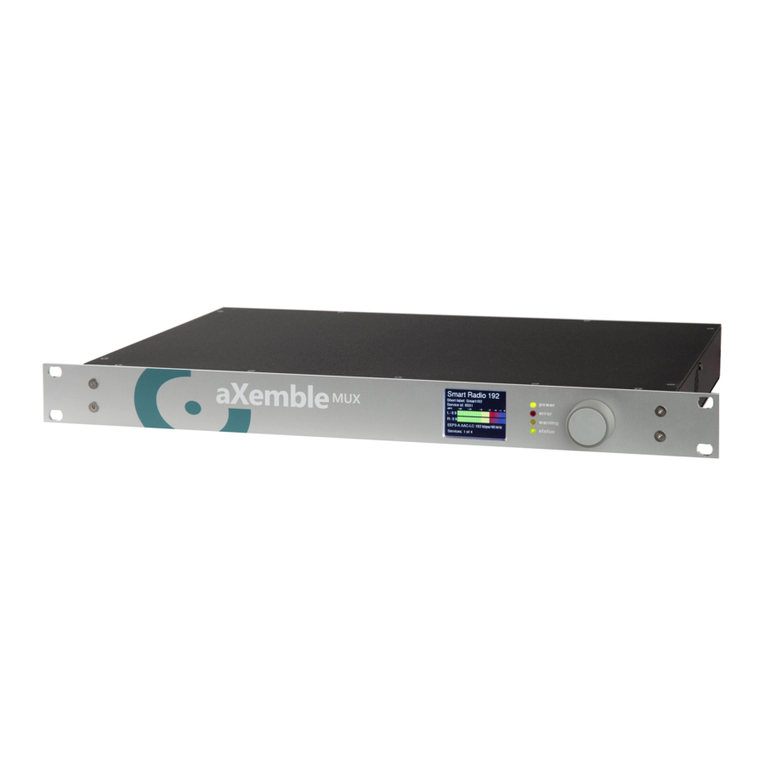network D-422-MG User manual

D-422-MG
RS-422 Multiplexer with GPI I/O
User Manual
Rev. 0

Network Electronics ASA
Thorøya
Sandefjord, Norway
Phone: +47 33 48 99 99
Fax: +47 33 48 99 98
e-mail: [email protected]
www.network-electronics.com
Direct Service Phone: +47 90 60 99 99
Revision history
The latest version is always available in pdf-format on our web-site:
http://www.network-electronics.com/
Current revision of this document is the uppermost in the table below.
Revision Replaces Date Sign Change Description
0 C 2006-05-11 OEH
GPI monitoring and control via GYDA
Added RS422 VTR master and slave pinouts
C B 2004.06.08 OEH Added CWDM channels 9-16.
B A 2004.05.28 OEH Added power/latency specification.
A Preliminary version. Pre production run.

Index
REVISION HISTORY ..........................................................................................................2
1GENERAL ...................................................................................................................4
2SPECIFICATIONS .......................................................................................................6
2.1 Electrical .............................................................................................................6
2.2 Inputs..................................................................................................................6
2.2.1 RS-422 .............................................................................................................6
2.2.2 GPI...................................................................................................................6
2.2.3 Optical input...................................................................................................6
2.3 Outputs...............................................................................................................6
2.3.1 RS-422 .............................................................................................................6
2.3.2 GPI...................................................................................................................7
2.3.3 Optical output ................................................................................................7
3CONNECTOR MODULE .............................................................................................8
3.1 D-422-MG-C1 .....................................................................................................8
3.2 Mounting the connector modules ....................................................................8
3.3 RS-422 Connector Pin Assignments ..................................................................9
3.4 GPI Input Connector Pin Assignments..............................................................9
3.5 GPI Output Connector Pin Assignments.........................................................10
4OPERATIONAL STATUS MONITORING ..................................................................11
4.1 GYDA – Monitoring and control .....................................................................11
4.2 Front Panel - Status Monitoring......................................................................11
5OPERATIONAL STATUS MONITORING ..................................................................13
DECLARATION OF CONFORMITY WITH CE ..................................................................14

D-422-MG Rev. 0
4
1General
Figure 1 D-422-MG Block diagram
The flashlink D-422-MG module provides an economical solution for transmitting RS-422
and GPI data signals via fiber optic cable. A pair of D-422-MG allows bi-directional
transmission of up to 8 RS-422 and 16 GPI data lines for distances over 60km. When
access to fiber is limited, D-422-MG can be combined with the flashlink optical
multiplexing WDM, CWDM or DWDM products.
The D-422-MG module multiplexes up to 8 RS-422 and 16 GPI inputs into an outgoing
datastream while at the same time demultiplexing an incoming datastream into 8 RS-422
and 16 GPI outputs. The outgoing multiplexed stream is available both as an optical
signal and as an electrical signal for use with a flashlink multichannel DWDM system.
As stand alone unit, the D-422-MG module utilises 2 fiber strands for bi-directional data
transport. Using either 2 fiber strands or optical multiplexing technology guarantees
minimum possible latency for applications where timing is crucial. The D-422-MG module
is supplied together with the D-422-MG-C1 connector module. The optical output is
made with a Fabry-Perot laser diode for 1310±40nm or a DFB laser for 1550±40nm and
the CWDM wavelengths according to ITU-T G.694 from 1470±6nm up to 1610±6nm.
The product is available in 19 versions:
D-422-MG-13T -7.5dBm 1310±40nm -7.5 dBm F-P laser
D-422-MG-13T 0 dBm 1310±40nm 0 dBm F-P laser
D-422-MG-15T 0 dBm 1550±40nm 0 dBm DFB laser

D-422-MG Rev. 0
5
CWDM
D-422-MG-C1470 1470±6nm 0dBm DFB laser
D-422-MG-C1490 1490±6nm 0dBm DFB laser
D-422-MG-C1510 1510±6nm 0dBm DFB laser
D-422-MG-C1530 1530±6nm 0dBm DFB laser
D-422-MG-C1550 1550±6nm 0dBm DFB laser
D-422-MG-C1570 1570±6nm 0dBm DFB laser
D-422-MG-C1590 1590±6nm 0dBm DFB laser
D-422-MG-C1610 1610±6nm 0dBm DFB laser
D-422-MG-C1270 1270±6nm 0dBm DFB laser
D-422-MG-C1290 1290±6nm 0dBm DFB laser
D-422-MG-C1310 1310±6nm 0dBm DFB laser
D-422-MG-C1330 1330±6nm 0dBm DFB laser
D-422-MG-C1350 1350±6nm 0dBm DFB laser
D-422-MG-C1370 1370±6nm 0dBm DFB laser
D-422-MG-C1390 1390±6nm 0dBm DFB laser
D-422-MG-C1410 1410±6nm 0dBm DFB laser

D-422-MG Rev. 0
6
2Specifications
2.1 Electrical
Power: +5V DC 0.8A 4W,
Control: Gyda system controller.
Monitoring: Front panel LEDs and Gyda system controller
RS-422 Latency: 500ns maximum single direction latency including
1m of fiber.
Additional latency 5µs/km of fiber.
GPI Latency: 5µs maximum single direction latency including
1m of fiber.
Additional latency 5µs/km of fiber.
2.2 Inputs
2.2.1 RS-422
Signal format: RS-422
Connector: RJ-45
Bit Rate: DC up to 115.2 kbps
2.2.2 GPI
Connector: DSUB 25
Signal type: Internal pull up to 5V
2.2.3 Optical input
Sensitivity: better than –30dBm
Max. input power: -3dBm
Optical wavelengths: 1310nm, 1550nm
Transmission circuit fiber: Multi Mode 50/125um, Single Mode 9/125um
compatible
Return loss: > 26dB
Connector: SC/UPC, Return Loss better than 40dB
2.3 Outputs
2.3.1 RS-422
Signal format: RS-422
Connector: RJ-45
Bit Rate: DC up to 115.2 kbps

D-422-MG Rev. 0
7
2.3.2 GPI
Connector: DSUB-25
Signal type: Open collector transistor.
Maximum voltage: 30 V
Maximum current: 100 mA
2.3.3 Optical output
Transmission circuit fibre: Single Mode
Light source: F-P/DFB Laser
Optical wavelength (ver. 13T): 1310nm ±40nm
Optical power: -7.5 dBm
Optical power (option): 0 dBm
Optical wavelength (ver. 15T): 1550nm ±40nm
Optical power: 0 dBm
Optical wavelength (ver. C1nn0): 1270, 1290, 1310, 1330, 1350, 1370, 1390, 1410,
1470, 1490, 1510, 1530, 1550, 1570, 1590,
1610nm ±6nm as per ITU-T G.694.2
Optical power: 0 dBm
Jitter (UI=unit interval): Max. 0.135 UI
Return loss: Typ. > 40 dB
Maximum reflected power: 4%
Connector: SC/UPC

D-422-MG Rev. 0
8
3Connector module
3.1 D-422-MG-C1
Figure 2 D-422-MG-C1 Connector module.
The D-422-MG has a dedicated connector module: D-422-MG-C1. This module is
mounted at the rear of the sub-rack. The module is shown in figure 2. Note that this
connector module always occupies two (2) slots in the sub-rack.
To set up a link, two D-422 modules must be used. The RS-422 data cable is connected to
RS-422/E1 on each of the D-422 modules. The two modules are connected to the fibres
with one fiber from TX on module 1 to RX on module 2, and from RX on module 1 to TX
on module 2. The TX UPG connector contains an electrical version of the modulated
signal running on the fiber. This connector is used for future upgrade with a flashlink
multichannel DWDM system.
3.2 Mounting the connector modules
The details of how the connector modules are mounted, can be found in the user manual
for the sub-rack frame: FR-2RU-10-2.
This manual is available from our web site: http://www.network-electronics.com/

D-422-MG Rev. 0
9
3.3 RS-422 Connector Pin Assignments
RS-422 shall be connected to one of the RS-422 connectors, positioned as shown in figure
2. The connectors are RJ-45 style, 8-pin modular jacks. Each connector has two RS-422
ports, referred to as ports 1 and 2 in the below table. In the event that only one port is in
use, an RJ-11 style 4/6 (4-wire, 6-position) jack can be used instead. Signals marked as
inputs on the D-422-MG shall be connected to the outputs of the connected devices, and
vice versa. The columns for DB9 VTR Master and Slave show which pin on the 9 pin DSUB
should be connected to the signal. Note that when connecting an active device instead of
a straight-through cable between a VTR master and slave (device and controller), one end
of the active device must use a crossed cable. The table below takes the crossing on the
slave side into consideration.
RS-422 pin layout:
Signal Name Port1 Port2 DB9 VTR
Master
DB9 VTR
Slave
Mode
RX + Receive Pos. Pin 3 Pin 1 Pin 3 Pin 7 Input
RX - Receive Neg. Pin 6 Pin 2 Pin 8 Pin 2 Input
TX + Transmit Pos. Pin 5 Pin 7 Pin 7 Pin 3 Output
TX - Transmit Neg. Pin 4 Pin 8 Pin 2 Pin 8 Output
Figure 3 RS-422 outlet
3.4 GPI Input Connector Pin Assignments
GPI inputs shall be connected to the DB25 connector marked “GPI
IN”. The pinout is the same as for the VikinX GPI panels, see table.
All inputs are internally connected to +5V via a pull-up resistor. The
inputs will be activated when pulling them to Ground.
Ground is available on the following pins: 2, 5, 8, 11, 13, 16, 19, 22,
25 and on the connector chassis.
Input Pin
1 12
2 24
3 23
4 10
5 9
6 21
7 20
8 7
9 6
10 18
11 17
12 4
13 3
14 15
15 14
16 1

D-422-MG Rev. 0
10
3.5 GPI Output Connector Pin Assignments
GPI outputs shall be connected to the DB25 connector marked
“GPI OUT”. The pinout is the same as for the VikinX GPI panels,
see table.
The GPI outputs are of open collector type. An output can
switch a maximum load of 100mA at 30V.
Any device to be controlled by the GPI outputs (lamp, LED or
similar) needs to be connected to an external supply voltage on
one end and to the GPI output on the other end.
Ground is available on the following pins: 2, 5, 8, 11, 13, 16,
19, 22, 25 and on the connector chassis.
Output Pin
1 12
2 24
3 23
4 10
5 9
6 21
7 20
8 7
9 6
10 18
11 17
12 4
13 3
14 15
15 14
16 1

D-422-MG Rev. 0
11
4Operational status monitoring
The status of the module can be monitored in two ways.
1. GYDA system controller module.
2. LED’s at the front of the sub-rack.
The LED’s are mounted on the module itself, whereas the GYDA-SC controller is a
separate flashlink module which presents the status of the flashlink modules in the
frame(s) as a web site.
The functions of the two monitoring systems are described below.
4.1 GYDA – Monitoring and control
From within GYDA it is possible to have alarms on loss of signal, loss of reclocker lock,
voltages, laser failure etc. As of firmware version 2.0.0 of D-422-MG it is also possible to
have alarms on each of the 16 GPI inputs, as well as the 16 GPI outputs. Only the GPI
inputs have alarms attached to them by default. Also, the same firmware version enables
control of the GPI outputs, so each output can follow remote input, drive active low or set
high impedance. All these functions are available from both web and SNMP. This means
that spare GPI inputs and outputs on D-422-MG can be used to extend GYDA with more
inputs and outputs.
4.2 Front Panel - Status Monitoring
The status of the module can be easily monitored visually by the LED’s at the front of the
module. The LED’s are visible through the front panel as shown in the figure below.
Figure 4 LED overview of D-422-MG
(Text not printed on the front panel).The D-422-MG has 3 LED’s. The colours of each of
the LED’s have different meanings as shown in the table below.

D-422-MG Rev. 0
12
Diode \ state Red LED Green LED No light
Status •Module initialising
(takes app 1 sec).
•The laser is turned off.
•Module is faulty (fuse
blown etc).
Module self-test is OK
and power is present.
Module has no power.
Loss of signal No optical input signal,
check fibre connection and
card in opposite end.
Optical input signal
present.
Laser fail Laser is malfunctioning. Laser is ok.

D-422-MG Rev. 0
13
5Operational status monitoring
Guidelines to limit hazards from laser exposure.
All the available EO units in the flashlink®range include a laser.
Therefore this note on laser safety should be read thoroughly.
The lasers emit light at wavelengths around 1310 nm or 1550 nm. This means that the
human eye cannot see the beam, and the blink reflex cannot protect the eye. (The
human eye can see light between 400 nm to 700 nm).
A laser beam can be harmful to the human eye (depending on laser power and exposure
time). Therefore:
!! BE CAREFUL WHEN CONNECTING / DISCONNECTING FIBER PIGTAILS (ENDS).
NEVER LOOK DIRECTLY INTO THE PIGTAIL OF THE LASER/FIBER.
NEVER USE MICROSCOPES, MAGNIFYING GLASSES OR EYE LOUPES TO LOOK
INTO A FIBER END.
USE LASER SAFETY GOGGLES BLOCKING LIGHT AT 1310 nm AND AT 1550 nm
Instruments exist to verify light output power: Power meters, IR-cards etc.
flashlink®features:
All the laser module cards in the flashlink®product range, are Class 1 laser products
according to IEC 825-1 1993, and class I according to 21 CFR 1040.10 when used in
normal operation.
More details can be found in the user manual for the FR-2RU-10-2 frame.
Maximum output power*: 5 mW.
Operating wavelengths: > 1270 nm.
*Max power is for safety analysis only and does not represent device performance.

D-422-MG Rev. 0
14
Declaration of conformity with CE
This apparatus meets the requirements of EN 55103-1 (November 1996) with regard to
emissions, and EN 55103-2 (November 1996) with regard to immunity; it thereby
complies with the Electromagnetic Compatibility Directive 89/336/EEC.
General environmental requirements for flashlink® equipment
The equipment will meet the guaranteed performance specification under the following
environmental conditions:
Operating room temperature range 0°C to 50°C
Operating relative humidity range up to 90% (non-condensing)
The equipment will operate without damage under the following environmental
conditions:
Temperature range -10°C to 55°C
Relative humidity range up to 95% (non-condensing)
Electromagnetic compatibility conditions:
Emissions EN 55103-1 (Directive 89/336/EEC)
Immunity EN 55103-2 (Directive 89/336/EEC)
Table of contents
Popular Multiplexer manuals by other brands
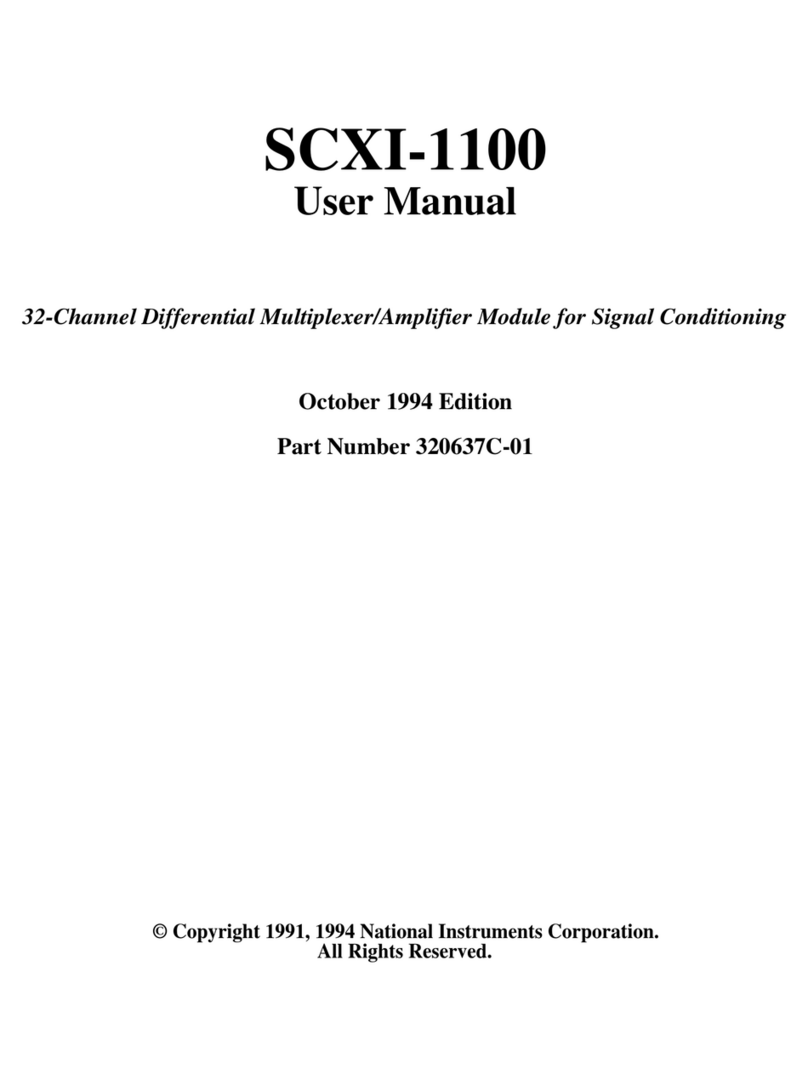
National Instruments
National Instruments SCXI-1100 user manual
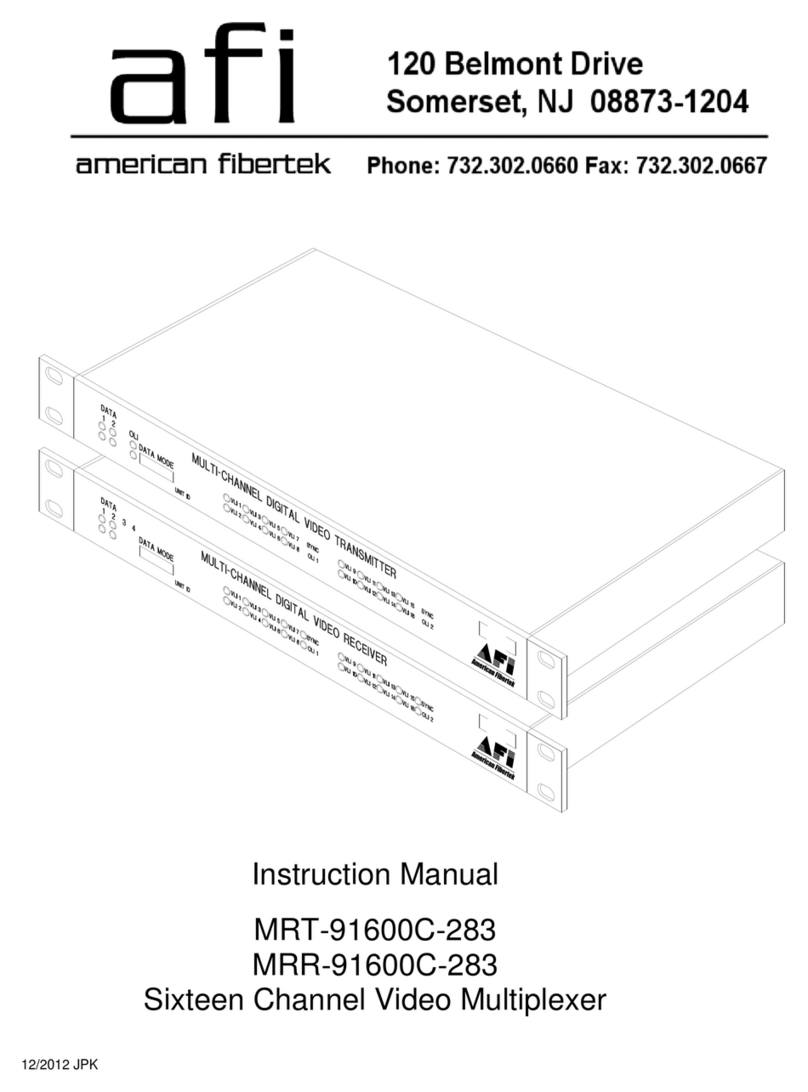
American Fibertek
American Fibertek MRT-91600C-283 instruction manual
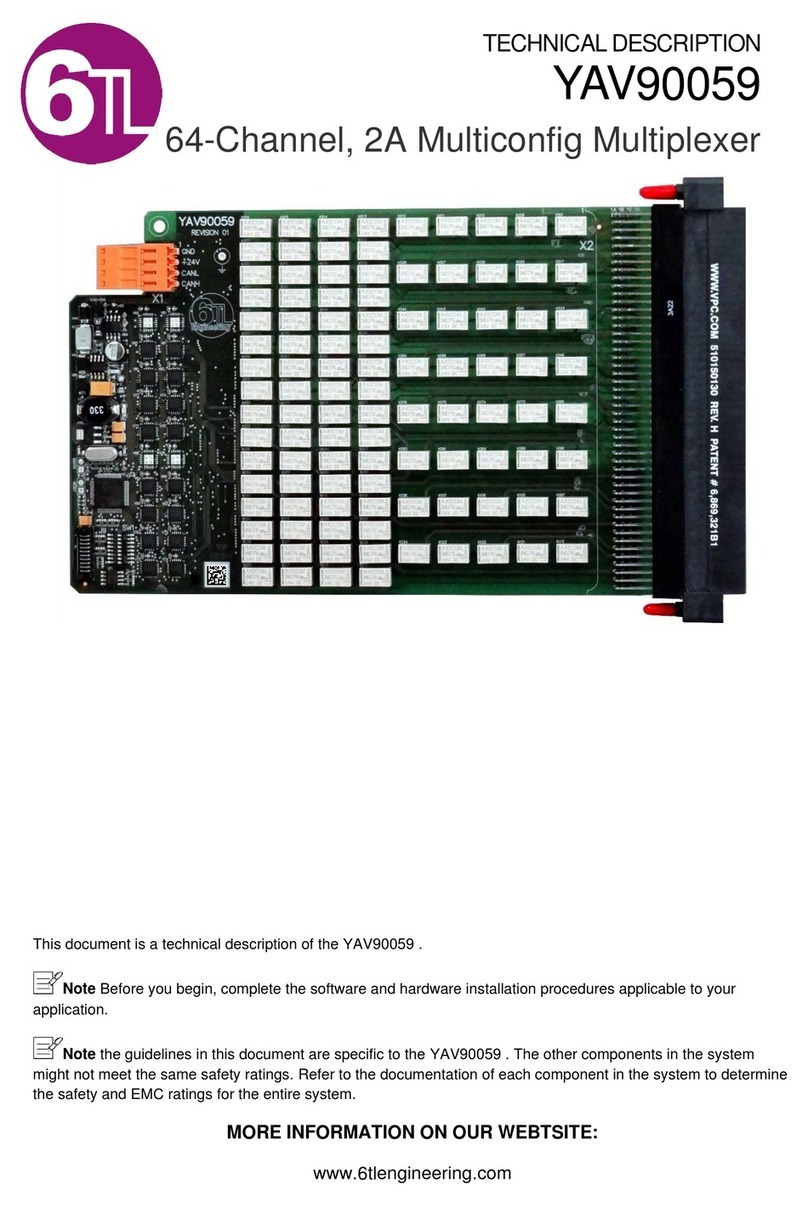
6TL
6TL YAV90059 Technical description

Stahl
Stahl ispac 9192 Series operating instructions

Philips
Philips LTC 2600 Series Quick reference guide

Pickering
Pickering 4 878 Series user manual



